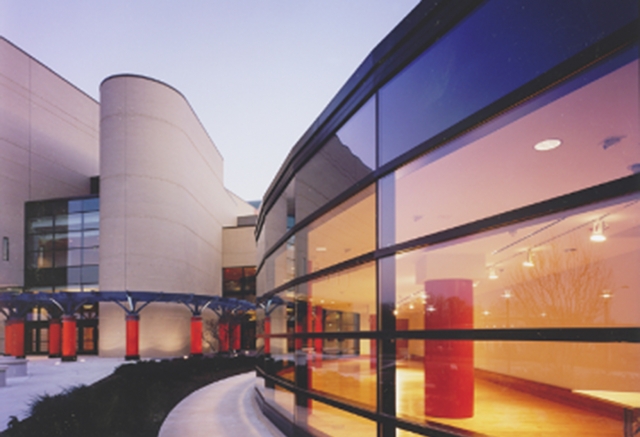Morgan State University, Murphy Fine Arts Center
�Henry Adams provided the mechanical, electrical, plumbing and lighting design for the new arts building at Morgan State University. The 140,000 SF building is the cultural center of the university and houses the Theater, Music and Art Departments. The three performance spaces include a 2,500-seat auditorium, a 250-seat theater and a 200-seat recital hall. An art gallery with adjunct areas for visitors is nearby. The building also includes offices, classrooms, practice rooms, art rooms, scenery and costume shops, and band and choral areas.
There is also an amphitheater for outdoor shows, which allows for informal musical performances and variety shows. Providing open air performance space, surrounded by static landscaping, and stadium-style seating for up to 200 people, the amphitheater is equipped with power for electrical equipment and instrumentation. The amphitheater is on the rear of the Murphy Fine Arts Center, and is built into the side of a hill providing privacy from regular, public traffic. Comfort facilities for performers and audience members are directly accessible inside of the building.
The mechanical and electrical design features an ice storage based chilled water plant, a heating plant, plumbing and fire protection systems, emergency power, lighting and electrical distribution. The air systems have been provided with humidification and, for the gallery, special filtration. The HVAC systems include the use of low velocity ducts and sound attenuators to achieve rooms with NC levels as low as NC20. Special duct and pipe wraps are specified to eliminate breakout noise to maintain the required sound levels.
Energy recovery is provided in seven of the nine custom air handling systems through the use of energy recovery wheels for these 100% outside air systems. Energy efficient design is reflected in the use of variable speed drives for both air and chilled water systems. The low temperature air and chilled water systems provide less flow with greater temperature differentials resulting in reduced horsepower. Outside air is shutoff during unoccupied periods and supply air temperatures are reset as far as possible while maintaining the required space relative humidity.
Special features of the building include the electrical metering system, which is tied through the building HVAC controls package for monitoring at the campus control center. Also included were exterior lighting controllers with individually assignable relays allowing quick reprogramming and overriding to adjust exterior lighting to meet needs of special events. A synchronous programmable clock system was provided throughout the building. A lightning protection system was provided. Voice evacuation speaker system was used throughout for the fire alarm system. The theater has a 1200-amp switchboard and complete theatrical dimming system. The auditorium has a larger 1600-amp switchboard and theatrical dimming system.
Transformers are served from a new 15 bay 13.2 kV fused switch lineup (with automatic transfer) designed as an addition to this project. It involved several medium voltage loops with pad mounted sectionalizing switches. The electrical system included two outdoor pads mounted 13.2 kV-480Y/277-volt transformers. The 1500 480-volt transformer was primarily for HVAC equipment and major equipment. The 1500 kVA 208-volt transformer was for lighting and receptacle loads. Both main switchboards utilized insulated case breakers with electronic monitoring for load tracking. Each switchboard has an integral transient voltage surge suppression system to reduce effects of lightning strikes and other disturbances.
The building uses energy saving dual technology motion sensors to control classroom and office lighting. Instant start lamps were specified because their “instant on” feature was most compatible with the motion sensors. Classrooms were also wired to allow instructor to override the auto-on feature for use with the LED ceiling mounted projection units. A self-contained emergency diesel fueled engine-generator set was provided in a walk-in sound attenuated enclosure. The set has a double walled subbase fuel tank with leak monitoring. The system is divided into emergency and standby branches as required by new NEC code.
Additional Information:
| Location | Baltimore, MD |
| Construction Value | $31,000,000 |
| Owner | Morgan State University |
| Architect | Gaudreau, Inc |




